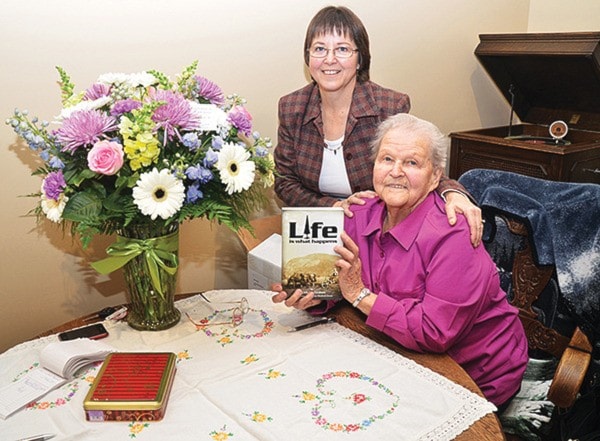When I was first told that former Revelstoke resident Alli Miriam (Luoma) Graham had penned her memoirs, I wondered – what made this woman’s life so interesting that she felt the need to write a book about it?
But then people started telling me that I had to speak to her and that any longtime Revelstokian would remember her for her letters to the editor that regularly appeared in the newspaper, her opinionated columns she used to write for the Revelstoke Herald, and her civic activism.
“I was a notorious bitch letter writer,” Graham, now 89, told me on the phone last week.
Graham was born in Chase, B.C., in 1924, the youngest of three girls. She had three brothers as well, but they all died very young. Her family moved to a homestead when she was three and she grew up on the farm, dropping out of school after Grade eight. She was raised doing tough, boys’ jobs.
“I think I was the boy that my father never was able to raise,” she said. “I think from my very early years I was doing boys’ chores, so I think that’s where it all started from when they saw I was capable of doing those jobs.”
Her early years took her around the Eagle Valley, from her family’s homestead to Salmon Arm, where she worked packing apples; to Tranquille, where she worked for a winter. Along the way she did may jobs that were considered men’s work, such as skidding firewood and cleaning chimneys. She attributes that to the way she was raised.
“I used to skid firewood every winter on my parents’ farm,” she said. “I even skidded firewood for the Japanese internment camp when it was open at Yard Creek during the war years.”
In March 1952, Graham moved to Revelstoke, where she got a job as a nurse at the old Queen Victoria Hospital.
After a few months there she got a new job as a housekeeper for Floyd Graham, a divorced railroader with three children.
“I became a sort of surrogate mother and wound up marrying the man,” she said. “We eventually had two more children, so I wound up raising five children.”
Graham’s time in Revelstoke was marked by a propensity for stirring up trouble. One of her early campaigns was with Marlene McQuarrie on behalf of citizens of the Farwell neighbourhood, who weren’t happy about paying the same taxes as people uptown, for fewer services.
“We were being charged the same as people uptown who had sidewalks, paved streets and finished homes. We were just completing our houses. We had a gravel road, it wasn’t a street, there were no sidewalks, and none of the amenities of uptown,” she said.
“We started a door-to-door quest to find out how other people in our area felt and there were lots of others in similar situations.”
They started a petition that they brought to city hall, where they found out there had been no tax revision in years.
“The long and the short of it was we won, so that was one of our crusades,” she said.
Graham would become known for her letters she would write to the now-defunct Revelstoke Herald in response to articles by editor Clay Stacey.
“We weren’t always on the same page, so I was very much surprised when he approached me one day and asked me to write a weekly column for him,” she said. “He said,‘Alli, the more controversial, the better.’”
One of her columns, about the scouts being kicked out of their drill hall by the city, had her threatened with a lawsuit. The director of parks and recreation demanded an apology, but she and her editor stood their ground.
“[Stacey] said, ‘Alli, you have arrived. No writer is worth his salt unless he’s been threatened with a lawsuit,’” said Graham.
Graham left Revelstoke in 1980, but she has continued writing letters to the editor. She hopes her book will appeal to people interested in the history of the Eagle Valley. She’s seen it change from the Roaring ’20s, through the Great Depression, the war years, the arrival of the Trans-Canada Highway and more.
Her memoirs started as a small venture to leave something for her family, and eventually turned into a full-blown, 500-page book, with 240 pictures from her life. It’s titled, simply, Life is What Happens.
“I think because so much of the topics are so localized, that’s what people are finding interesting,” she said. “I’m local pretty well all the way along. I really haven’t drifted too far from my early surroundings.”
